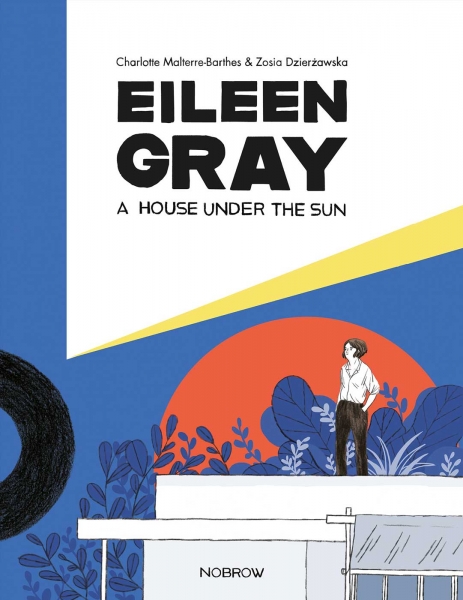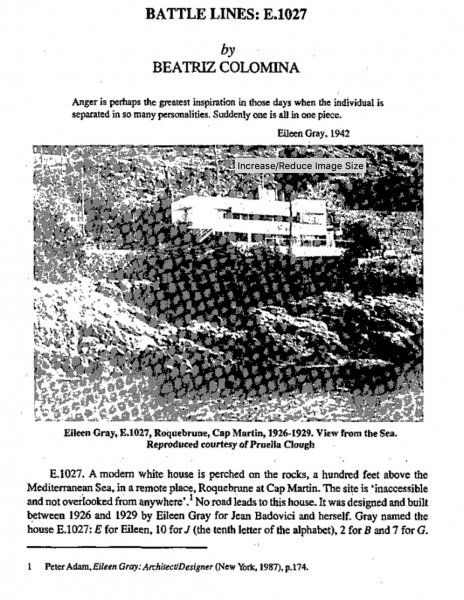Research Practice
A Militant Comic
A long-term pet project, 'Eileen Gray: A House under the Sun' is a graphic novel published in 2019 with Nobrow, London. Sparked by a reading of Beatriz Colomina's contentious paper 'Battle Lines: E1027', the desire to illuminate the architecture of Gray, the project fits into pursuing a political agenda of exposing female designers' work and doing justice to their overlooked careers.
First envisioned as an opera libretto, then as a script, the format of a graphic novel imposed itself as the right media to convey a story accessible to non-architects and professionals alike. A visit to the Fondation Le Corbusier allowed for in-depth archival research in Gray, Jean Badovici and Le Corbusier's correspondence, but it is the field trip at Rocquebrune in May 2017 that was instrumental in mining the spatial reality of the house, of its surroundings and immerse in the spirit of the Meditérannée that Gray loved dearly. There, the splatters of color left by Le Corbusier's murals could not but be understood as a regrettable intervention, an impression conveyed in the book. Not intended as a biography, 'Eileen Gray: A House under the Sun' tells the story of the house, with flashbacks and flash-forwards in the life of Gray, in order to offer a composite feeling of the house as an unjustly overlooked outstanding work.
2019, with Zosia Dzierzawska
The work has been translated and published in the following languages:
-Polish
-French
-Spanish
Litterature Reviews
Eileen Gray: A House Under the Sun
Charlotte Malterre-Barthes and Zosia Dzierzawska. Nobrow, $19.95 (160p) ISBN 978-1-910620-43-4
"A perceptive and wholly plausible reading of the protagonist’s conflicting emotions is to be found in an extraordinary graphic novel, Eileen Gray: A House Under the Sun, written with sensitivity and tact by the French architect Charlotte Malterre-Barthes and illustrated with complementary wistfulness by the Polish graphic artist Zosia Dzierżawska. It rings true not only in its factual aspects, but especially in its poignant acknowledgment of Gray’s essentially divided nature. The book skillfully intercuts flashbacks that juxtapose aspects of Gray’s inner life in illuminating ways. For example, her neglectful Irish upbringing is depicted not as the prelapsarian paradise the architect recalled, but more like one of the Gothic ordeals in Edward Gorey’s Gashlycrumb Tinies. Her immersion in the giddy lesbian demimonde of 1920s Paris is no less vividly portrayed, as in a depiction of a freewheeling soirée at the American novelist and saloniste Natalie Barney’s Temple d’Amitié, her Neoclassical garden folly on the Left Bank, a short walk from Gray’s flat."
— The New York Review, Martin Filler
"Of course any graphic biography that avoids heavy narration will always be something of a narrative shorthand but Eileen Gray: A House Under the Sun is more a book that asks us to recognize the suppression of the achievements of a pivotal voice in the arts as it is one looking to detail the minutiae of the subject’s existence; the impetus being on providing an expression of her life to interact with rather than provide a direct commentary on it. Backed up with supplementary material it also invites the reader to investigate its subject further; a fitting aim for a book that seeks to redress a balance and give this important figure the recognition she rarely got in her own lifetime."
— Broken Frontier
"This gorgeous but fragmented narrative aims to bring overdue attention to Eileen Gray, a bisexual Irish interior decorator, and architect who spent the majority of her life in France, but the snapshot structure resists any attempt to read it as a comprehensive biography. In fact, the opening scene focuses not on Gray but on the most well-known building she designed, E-1027. Swiss architect Le Corbusier stayed there and painted the interior walls with his own brightly colored murals, in defiance of Gray's aesthetics, and he was swimming in the sea near the house when he died in 1965. The brief chapters ricochet out of chronological order, bouncing from when Gray still lived with her lover Jean Badovici, a Romanian architect; to her childhood amongst a family of five children and an absentee artist father; to her first introduction to lacquer, a medium she loved; and so on. Illustrated with soft crayon lines and a neutral palette—except where Corbusier’s paintings break the color scheme with bright intrusion—the layouts are lovely and evocative of Gray’s creative process."
— The New York Journal of Books




